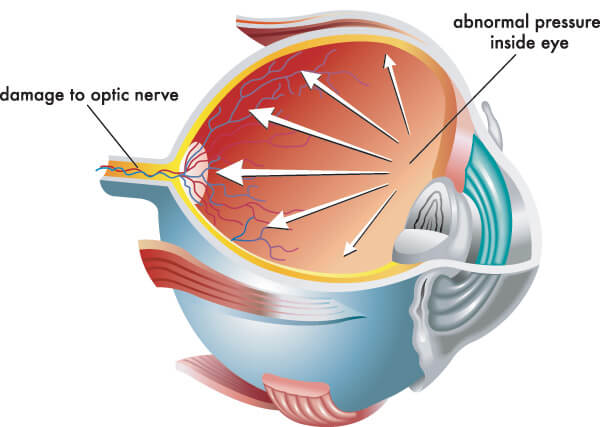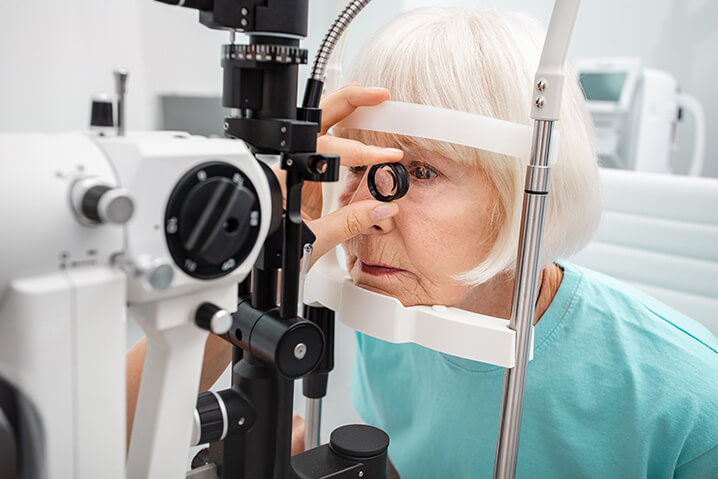Glaucoma is one of the leading causes of blindness in the United States. It is estimated that three million Americans have glaucoma but that only about half of them have been diagnosed with it. Because the condition is not usually followed by any pain or symptoms in its early stages, it is often called the “silent thief of sight”.
The expert doctors and surgeons a part of St. Luke’s at The Villages team are dedicated to the early detection and treatment of glaucoma to preserve their patients’ vision.
If you or someone you know is struggling with glaucoma and needs an expert opinion, call 352-775-0080 or click the button below to schedule an appointment.
What is Glaucoma?
Glaucoma is a disease that damages the eye’s optic nerve. This nerve damage is caused by increased pressure in the eye, known as intraocular pressure (IOP), which is due to a buildup of fluid that flows throughout the eye. Normally, this internal fluid—called aqueous humor— drains out through a complex drainage system known as the anterior chamber. When eye pressure is normal, fluid flows throughout the anterior chamber and drains out through an opening called the trabecular meshwork. When this complex and delicate drainage system does not work properly, the aqueous humor is unable to flow out at a normal rate, leading to an increase in IOP. As the pressure inside the eye rises, the optic nerve experiences damage. Increased IOP alone does not cause glaucoma, but it is a significant risk factor.
If left untreated, elevated IOP can lead to irreversible damage to the optic nerve and retinal fibers. This can result in a progressive, permanent loss of vision. However, early detection and treatment can slow the progression of the disease.
Most forms of glaucoma have no warning signs or symptoms. Rather, the effects of the condition are so gradual that one may not notice a change in his or her vision until the condition is at an advanced stage.
Common Types of Glaucoma
Open-angle Glaucoma
Open-angle Glaucoma (also referred to as chronic open-angle or primary open-angle glaucoma) is the most common type of glaucoma and accounts for at least 90% of all glaucoma cases. This type of glaucoma is caused by the slow cogging of the eye’s drainage canals, which results in increased eye pressure. Open-angle glaucoma develops slowly, is a lifelong condition, and its symptoms and the damage it causes may often go unnoticed until one begins to lose their vision. As the name suggests, with this type of glaucoma, there is a wide, open angle between the iris and the cornea. People with high blood pressure or diabetes are at a higher risk for this type of glaucoma.
Angle-closure Glaucoma
Angle-closure Glaucoma (also referred to as closed-angle, acute-angle, or narrow angle glaucoma) is a less common form of glaucoma and only accounts for about 10% of glaucoma cases. In this type of glaucoma, one has a closed or narrow angle between his or her iris and cornea, which blocks the aqueous humor from draining out of the eye. The blocked drainage canals lead to a sudden rise in intraocular pressure. Angle-closure glaucoma develops very quickly and has symptoms that are usually very noticeable. Symptoms may include eye pain, nausea, blurred vision, rainbows around lights, and a red-eye. This problem is a medical emergency and should be treated by an ophthalmologist immediately.
Secondary Glaucoma
Secondary Glaucoma is used to describe glaucoma that is caused by another medical condition. Unlike other types of glaucomas, there is an identifiable cause of the the increase in eye pressure with secondary glaucoma. It may be caused by an eye injury, inflammation, trauma, tumors, or by certain drugs used to treat advanced cases of diabetes or cataracts. For this type of the condition, both the glaucoma and the underlying problem must be treated.
Congenital Glaucoma
Congenital Glaucoma is a form of glaucoma that occurs in babies when the eye’s drainage canal is incorrectly or incompletely developed during the prenatal period. This rare condition type may be inherited, and only about 1 in 10,000 babies born in the United States are born with it.
Treatment of Glaucoma
The damage caused by glaucoma is irreversible, but regular checkups paired with treatment can aid in slowing the progression of the condition or can help in preventing vision loss if the condition is caught in its early stages. Glaucoma is treated by lowering IOP through eye drops, oral medications, surgery, laser treatment, or a combination of any of these options.
Oftentimes, glaucoma treatment begins with prescription eye drops. Prescription eye drops can improve how fluid drains from the eye or can work to decrease the amount of fluid the eye produces, both of which can help decrease eye pressure. If eye drops themselves do not bring IOP down to a sufficient enough level, they may be paired with an oral medication. Other treatment options include surgery and laser therapy which are techniques meant to improve fluid drainage in the eye, and in turn, lower pressure.
Surgery is needed when other treatments are unsuccessful in lowering eye pressure to the desired level. There are several types of procedures that can be done; at St. Luke’s at The Villages some of these procedures are done in the clinic office area, while others are done in the surgery center. The objective of any glaucoma operation is to allow the fluid to drain from the eye more efficiently.
Glaucoma is an eye condition in which the pressure inside the eye builds up and in turn, damages the eye’s optic nerve. As the pressure increases, so does the damage done to the optic nerve. As the damage worsens, it can lead to permanent vision loss or even total blindness. There are various treatment options ranging from eye drops to surgery that is dependant on the severity of a patient’s glaucoma. Call 352-375-0080 to schedule an appointment to discuss available options for treating your Glaucoma!













